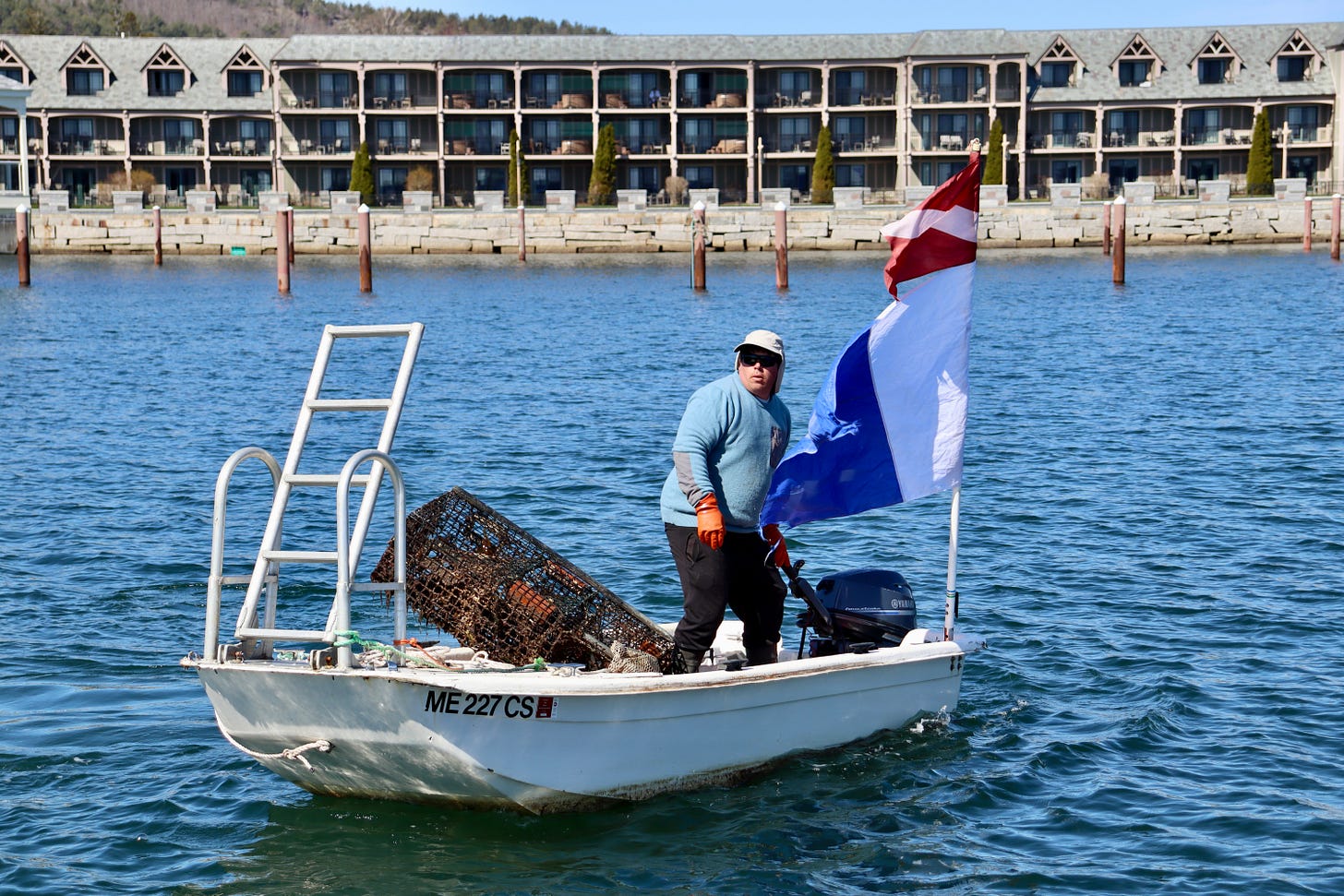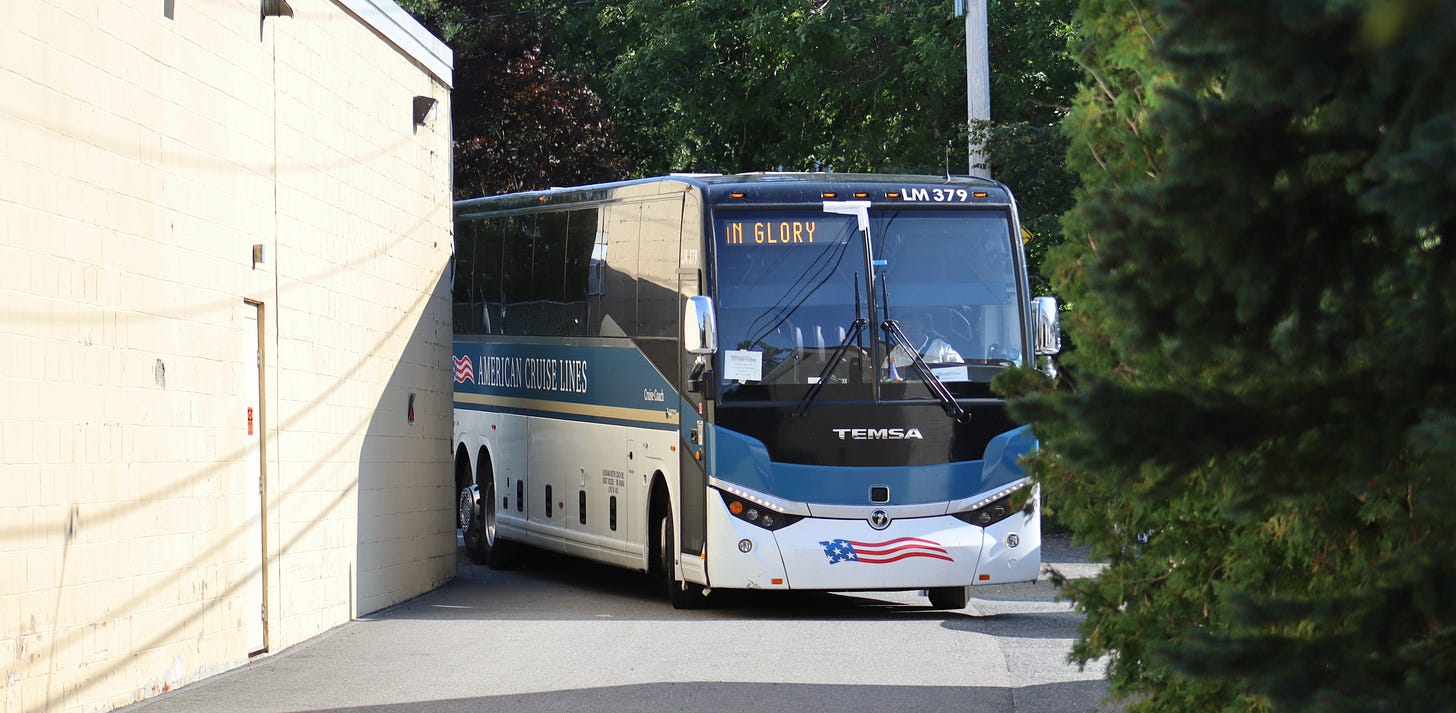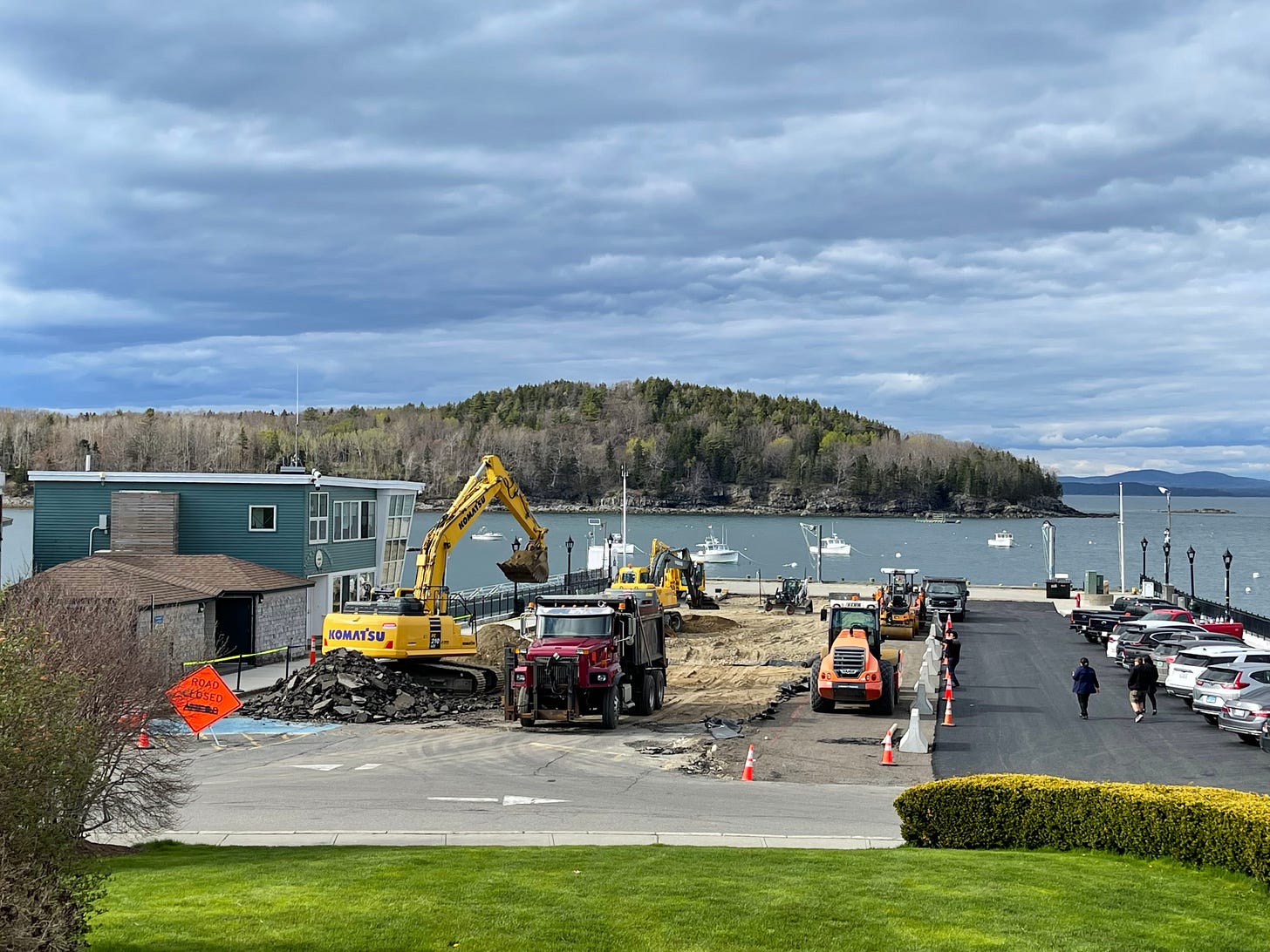BAR HARBOR—During the Bar Harbor Town Council’s Tuesday workshop, which was meant to get a feel from the councilors about multiple potential issues, Town Manager James Smith brought up a request from American Cruise Lines to tender passengers to the town-owned Ells Pier and potentially eventually to the town-owned ferry terminal.
That terminal site is planned to be a marina and is currently partially leased to Bay Ferries, which runs the CAT to Nova Scotia.
Former Councilor Jill Goldthwait requested that the councilors get feedback from the local fishing community before moving forward with the use of the space for tendering that cruise line.
“This is not a forum that’s easy for fisherman,” Goldthwait said of the night-time workshop.
Goldthwait said she is anxious that what happens in the workshop might begin to emerge as policy before the fishermen have an opportunity to voice their opinions.
“Just to say that this is not a forum that’s easy for fisherman. I am not a fisherman; I do not speak for fisherman, but I have worked for a long time with fisherman, and I am anxious that what happens in this room begins to emerge as policy before we start hearing from the fishermen that they hate it,” Goldthwait said.


“Fishing is kind of one of the last shreds of authenticity in our community. The tourists love to see the boats come in. They will stand on the pier, watch the guys unload. The fishermen have expressed before, in the ferry terminal issues, that they do not care to be schlepped off to Hulls Cove. They want to come into the town pier; it’s their place,” Goldthwait said.
“I think we should do everything possible to preserve that in my opinion but particularly to get the point of view of the fishermen,” she said. “There is nothing that replaces the voice of a fisherman coming out and talking about how they feel about this and there may have to be some other way to get that opinion than an evening meeting for a guy whose been on a boat in 10 degree weather for 12 hours.”
Harbormaster Christopher Whaff said that he doesn’t believe tendering the small ships, which use smaller tenders, would interact or interfere with current activities at the town pier. Two transient piers exist and tendering would be to one of the floats. The infrastructure needs would be a more ADA-compliant gangway and a digital system to count passengers to make sure that they are being compliant with the 1,000-disembarkation cap, he said.
Councilor Matthew Hochman said he liked the idea of tendering to the ferry terminal. Vice Chair Gary Friedmann said he liked everything about the plan including upgrading the pier and the digital monitoring system needed. He’d love to see it go forward.
Councilor Earl Brechlin asked if this would get run by the harbor committee. He also agreed with Goldthwait and said it would be nice to have fishermen discuss this so that the council isn’t overlooking anything.
It is now on the harbor committee’s January 13 agenda.
Town Council Chair Valerie Peacock had concerns, which included the clause in the proposal that allowed for up to 1,000 passengers on the town pier. Smith said the intention in that clause was to assure the public that it would follow the citizen’s initiative guidelines, but that the language could be tweaked to just American Cruise Lines. Peacock also said one of her goals wasn’t to assure access to cruise ships, which was language in another whereas clause. She worried that it was prioritizing the use of tendering in those spaces over other uses. She also wanted to see the costs and revenue structure for the possibility before voting on it.
“I also want to see, I’d like to see before I vote for anything to go through, what we are thinking about in terms of the cost and the revenue structure of this in terms of the infrastructure and staff time and how that works, and what we are thinking about what this looks like in terms of how much money we might make to do as well,” Peacock said. “If we are going to give away that access, it can’t be for free. You know, 100 passengers is not a lot, when you do per passenger things. . . . If they are only charging eight dollars per passenger, it’s $800. It’s not like we’re going to be making millions of dollars doing this, so it’s a real resource that we are putting out there, and it is a super important one for me and for the people that, for this whole town I think.”
Peacock doesn’t think it shouldn’t be about whether another pier is available or not. It should be done—if it is done—because it’s an opportunity for the town.
Because American Cruise Lines ships are United States flagged vessels, the town doesn’t need a secure facility, according to Harbormaster Chris Wharff. The company’s tenders tend to carry 30 passengers at a time.
The next step will be for Wharff to put the proposal on the town’s harbor committee’s agenda and look for input from the fishing community.
POTENTIAL DRAFT ORDER TO UPGRADE TOWN PIER FOR USE AS CRUISE SHIP DISEMBARKATION FACILITY
While the potential draft order authorizing the “town manager or his designee” to perform a number of actions so that the town pier may be utilized as a licensed disembarkation facility, the core justifications in the order and comments made by councilors at Tuesday night’s workshop appear to shore up that these actions would only allow one cruise line currently listed on PortCall. The total potential benefit to the town is not completely known due to multiple variables—the biggest variable would be how many American Cruise Lines (ACL) ships would visit.
The order states, “WHEREAS, there is a need to ensure continued access by cruise ship operators to disembark passengers in the Town of Bar Harbor.”
The plan stated at the workshop appears to limit the “cruise ship operators” to only ACL since no CFR105 facility security plan is needed for American-flagged vessels. This means that there would need to be no areas of segregation or restricted access zones other then most likely from the top of the gangway down to the floating dock where the tenders would disembark passengers. This, in theory, would mean no loss of access to the normal publicly accessible portion of the pier.
At the workshop, Peacock said, “I would like to have a better understanding of what the security situation looks like, too, like how much . . . with people coming on and off, like how much of that space has to be blocked off.”
“None. U.S. flagged vessels don’t require any security. We don’t have to have a CFR105 secure facility. It literally just requires what is there,” Wharff said. He added, “It will always be the inboard float that is near the (boat) ramp, so not interfering with what’s happening on the end of the pier.”
The order states, “WHER(E)AS, the town wants to ensure that Cruise Ships desiring to disembark up to 1,000 passengers per day have a properly licensed and permitted location to do so.”
Based upon the cruise ships currently listed on PortCall, the town pier would only be available to ACL due to the lack of a facility security plan. There are 20 additional ship visits listed on PortCall as either “booked or “requested” with one showing “conflict” that are under 1,000 passengers, but they are all foreign flagged.
Additionally, at the workshop, Peacock said, “There is a whereas clause in here that talks about ensuring that cruise ships desiring to disembark up to 1,000 passengers and I am like, I don’t think . . . There is no way you can put 1,000 passengers on the pier without having everyone come to the town pier, so I just, I don’t know that, I don’t feel like we need to ensure that every cruise ship that wants to come in here up to 1,000 passengers has a place at the town pier. I am not interested in that at all.”
It’s unknown if other councilors shared Peacock’s sentiment that Ells Pier should not handle the disembarkation of 1,000 passengers a day. Of the 20 additional ship visits on PortCall with that lower passenger number of 1,000 or less, 10 have a lower berth capacity of greater than 700 passengers.
Peacock later said, “I think there is a scale where it works, and I think there is a scale where it doesn’t.”
“I agree,” said Hochman.
“If they (ACL) are building more boats, if there are like three of them in a day and that leads to different sized tenders than that’s a different story,” Peacock added.
The order states, “WHEREAS, if no private facilities apply for permits to operate as a CSDF, it would require cruise ship operators to make the difficult decision to either partner with an illegal disembarkation operation or abandon Bar Harbor as a port of call.”
This potential draft order forces all cruise ship operators currently listed on PortCall even those under 1,000 lower berth capacity, with the exception of ACL, to make the choice to “either partner with an illegal disembarkation operation or abandon Bar Harbor as a port of call.”
The order states, “WHEREAS, the Town Council recognizes the economic and strategic importance of maintaining Bar Harbor’s reputation as a premier cruise ship destination.”
Given the limitations mentioned above, the strategic importance is limited to only ACL and is invalidated from the majority of other cruise lines due either to the lack of a security plan or the potential unwillingness of the town to disembark 1,000 passengers at the town pier.
Taking into account that all of the potential cruise ship visits that are currently listed on PortCall.com, with the exception of ACL ships, are either foreign flagged or well over 1,000 lower berth capacity, the “economic and strategic importance of maintaining Bar Harbor’s reputation as a premier cruise ship destination” may be questionable.
Currently, there are 29 ACL ships listed on PortCall, some “booked” and some still showing as “requested.” The current rate for the passenger service fee charged by the town is $2.93. The current rate for the port development fee charged by the town is $2.61 for a total fee of $5.54
Historically, the fees have been increased at the rate of cost of living increases for the corresponding fiscal year and have ranged from 3% to 6%. Perceived arbitrary increases in these fees by the town would still be constrained by case law set in 2016 by Cruise Lines International Alaska vs. the City and Borough of Juneau Alaska, et al. In that case, Juneau was charging fees totaling $8.00 per passenger, a $5.00 marine passenger fee and a $3.00 port development fee.
Of the 29 potential ACL visits currently listed on PortCall, 15 have a listed lower berth capacity of 100 and 14 have a listed lower berth capacity of 109 for a total passenger count of 3,026. At the current fee rate charged by the town that would equal $16,764 for the season. At the rate of $8.00 per passenger, the town would garner $24,208. As far as economic importance is concerned, neither of these amounts covers the $25,000 contribution to the ferry terminal debt service that has come from the cruise ship fund for at least the past four fiscal years.
However, the eventual decisions from multiple ongoing court cases could impact those numbers.
BUS LOADING AND UNLOADING
The topic of bus loading and unloading at the town pier was not covered at the workshop, but ACL does utilize at least one bus for passenger tours and brings its own bus to town.

ANCHORING IN A BAR HARBOR ANCHORAGE WITHOUT A CONFIRMED RESERVATION
The town fined American Cruise Lines $885 in July 2023, which was the passenger fee of $5.21 per person for a berth capacity of 170. The company agreed to not anchor its ships in Bar Harbor waters again without a confirmed reservation.
ACL also accepted service of a notice of violation after the town alleged that the cruise line had violated town rules and a memorandum of agreement between the town and the cruise line and anchored the 170-person vessel, the American Constitution, within Bar Harbor waters without a confirmed reservation on June 15, 2023.
EFFLUENT DISCHARGE
In a 2012, Mount Desert Islander article, Robert Levin wrote that someone had reported a discharge coming from the 100-passenger ACL ship, American Independence, while it was tied up at the town pier two years prior.
“It was enough to discolor the water around the ship and had some odor to it,” then Harbormaster Charlie Phippen told the Bangor Daily News’ Bill Trotter for a 2010 article.
Immediately after that, Dr. Jane Disney’s lab tested the water and found Enterococci bacteria at levels of “228 parts per 100 million, slightly more than twice the concentration level of the bacteria that correlates to illnesses in humans,” Trotter wrote.
Shortly afterward, the water was tested and found 40 colonies of Enterococci bacteria. There had been an employee error that caused the discharge of laundry effluent. The procedures for that have since changed.
Another test that same year at Bar Harbor’s Anchorage B indicated 31 colonies. The source was unknown. This information was included in a report by Paul C. Leeper of Moody Mountain Environmental. The report was meant to see if cruise ships were complying with water quality laws. A similar study had occurred in 2004. The state has regulated cruise ship discharge that could occur within three miles since 2006.
Disclaimer: Shaun Farrar is the co-founder of the Bar Harbor Story, co-writer of this piece, and is also an elected member of the Bar Harbor Warrant Committee, which deals with budget and ordinance recommendations. We know that most of you know this, but we want to make sure that you always do.
If you’d like to donate to help support us, you can, but no pressure! Just click here (about how you can give) or here (a direct link), which is the same as the button below. Our mailing address is 98 Ledgelawn Ave., Bar Harbor, Maine, 04609
If you’d like to sponsor the Bar Harbor Story, you can! Learn more here.








